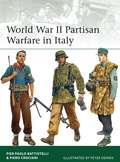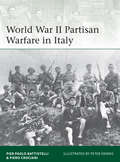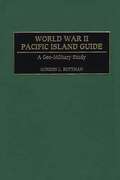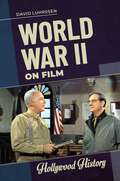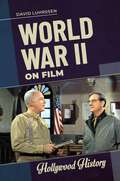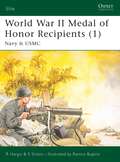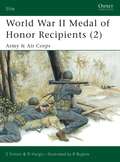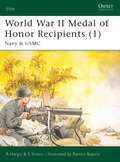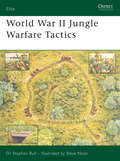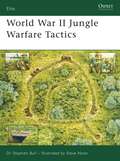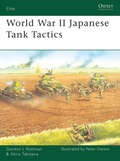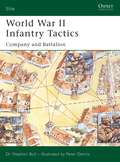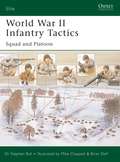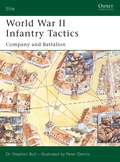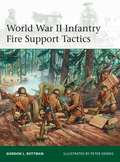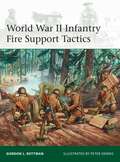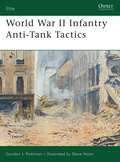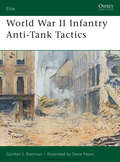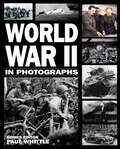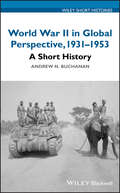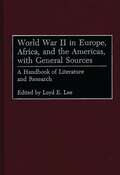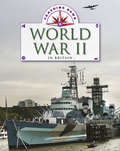- Table View
- List View
World War II Partisan Warfare in Italy (Elite)
by Peter Dennis Pier Paolo Battistelli Piero CrocianiWhen Italy surrendered in 1943, it sparked a resistance movement of anti-German, anti-fascist partisans. This book explores the tactics, organizational structure and equipment of the brave Italian resistance fighters. Beginning with low-level sabotage and assassinations, the groups continued to grow until spring 1944 when a remarkable, unified partisan command structure was created. Working in close co-ordination with the Allies, they received British SOE and American OSS liaison teams as well as supplies of weapons. The German response was ferocious, and in autumn 1944, as the Allied advance stalled, the SS and Italian RSI looked to eradicate the partisans once and for all. But when the Allies made their final breakthrough in the last weeks of the war the partisans rose again to exact their revenge on the retreating Wehrmacht. From an expert on Italian military history in World War II, this work provides a comprehensive guide to the men and women who fought a desperate struggle against occupation, as well as the German and Italian fascist security forces unleashed against them.
World War II Partisan Warfare in Italy (Elite)
by Peter Dennis Pier Paolo Battistelli Piero CrocianiWhen Italy surrendered in 1943, it sparked a resistance movement of anti-German, anti-fascist partisans. This book explores the tactics, organizational structure and equipment of the brave Italian resistance fighters. Beginning with low-level sabotage and assassinations, the groups continued to grow until spring 1944 when a remarkable, unified partisan command structure was created. Working in close co-ordination with the Allies, they received British SOE and American OSS liaison teams as well as supplies of weapons. The German response was ferocious, and in autumn 1944, as the Allied advance stalled, the SS and Italian RSI looked to eradicate the partisans once and for all. But when the Allies made their final breakthrough in the last weeks of the war the partisans rose again to exact their revenge on the retreating Wehrmacht. From an expert on Italian military history in World War II, this work provides a comprehensive guide to the men and women who fought a desperate struggle against occupation, as well as the German and Italian fascist security forces unleashed against them.
World War II Pacific Island Guide: A Geo-Military Study
by Gordon RottmanCovering all Pacific islands involved in World War II military operations, this book is a detailed, single source of information on virtually every geo-military aspect of the Pacific Theater. Arranged regionally and, to the extent possible, chronologically according to when islands entered the war, entries provide complete background information. Along with island names, nicknames, Allied code names, location, and wartime time zones, the entries include such topics as the island's physical characteristics, weather, health hazards, historical background, native population, natural resources, and military value. Japanese and Allied strategies and operations, military problems caused by terrain, military installations, Japanese units and key commanders, Allied units and key commanders, and brief battle descriptions are also covered along with the island's postwar status.A valuable resource for researchers, historians, military history enthusiasts, and war gamers, the book provides complete background information on the geo-military aspects of the Pacific Ocean region, its islands, and the roles they played in the war. 108 maps provide specific information. Until now, geo-military information could only be found by searching four to ten publications on each island.
World War II on Film (Hollywood History)
by David LuhrssenWorld War II on Film examines the war through the lens of 12 films. The movies selected include productions made during World War II and in each succeeding decade, providing a sense of how different generations perceive the war.World War II on Film provides a succinct yet well-grounded appraisal of that war as seen through 12 representative films. The book separates fact from fiction, showing where the movies were accurate and where they departed from reality, and places them in the larger context of historical and social events. Each movie chosen represents a particular aspect of the conflict, including the air war over Europe, the condition of prisoners of war, Nazi atrocities, and the British evacuation at Dunkirk. Unlike most histories of Hollywood during World War II or the genre of war movies, World War II on Film examines in depth the relation between the depictions of events, beliefs, attitudes, and ways of life as seen on film with reality as documented by historians or recorded by journalists or eye-witnesses to the war. The volume will appeal to high school and college readers, as well as general interest readers and film buffs.
World War II on Film (Hollywood History)
by David LuhrssenWorld War II on Film examines the war through the lens of 12 films. The movies selected include productions made during World War II and in each succeeding decade, providing a sense of how different generations perceive the war.World War II on Film provides a succinct yet well-grounded appraisal of that war as seen through 12 representative films. The book separates fact from fiction, showing where the movies were accurate and where they departed from reality, and places them in the larger context of historical and social events. Each movie chosen represents a particular aspect of the conflict, including the air war over Europe, the condition of prisoners of war, Nazi atrocities, and the British evacuation at Dunkirk. Unlike most histories of Hollywood during World War II or the genre of war movies, World War II on Film examines in depth the relation between the depictions of events, beliefs, attitudes, and ways of life as seen on film with reality as documented by historians or recorded by journalists or eye-witnesses to the war. The volume will appeal to high school and college readers, as well as general interest readers and film buffs.
World War II Medal of Honor Recipients: Navy & USMC (Elite #92)
by Ramiro Bujeiro Robert Hargis Starr SintonThe Medal of Honor is the highest military award that can be bestowed on personnel in the United States' Armed Forces. This book is the first of two titles looking at the recipients of the Medal of Honor during World War II. It covers Navy and Marine Corps awardees in all theaters of war, from the attack on Pearl Harbor in 1941 to the brutal fighting on Iwo Jima in 1945. Among the inspiring stories told are those of Signalman 1st Class Douglas Munro, the only Coast Guardsman to ever receive the Medal of Honor, and Commander Antrim, who faced almost certain death to save fellow prisoners in a Japanese prisoner of war camp.
World War II Medal of Honor Recipients: Army & Air Corps (Elite)
by Ramiro Bujeiro Robert Hargis Starr SintonThe Medal of Honor is the highest award for valor in action against an enemy force that can be awarded to personnel in the United States' Armed Forces. From the early fighting in the Philippines through the D-Day landings in Northwest Europe to the final assaults in the Pacific, this book looks at the brave US soldiers and airmen who were awarded the Medal of Honor for their actions in the face of danger. It tells the exciting combat stories of such famous figures as the film star Audie Murphy, one of the most decorated US soldier of WWII, alongside less well-known awardees.
World War II Medal of Honor Recipients: Navy & USMC (Elite #92)
by Ramiro Bujeiro Robert Hargis Starr SintonThe Medal of Honor is the highest military award that can be bestowed on personnel in the United States' Armed Forces. This book is the first of two titles looking at the recipients of the Medal of Honor during World War II. It covers Navy and Marine Corps awardees in all theaters of war, from the attack on Pearl Harbor in 1941 to the brutal fighting on Iwo Jima in 1945. Among the inspiring stories told are those of Signalman 1st Class Douglas Munro, the only Coast Guardsman to ever receive the Medal of Honor, and Commander Antrim, who faced almost certain death to save fellow prisoners in a Japanese prisoner of war camp.
World War II Medal of Honor Recipients: Army & Air Corps (Elite #95)
by Ramiro Bujeiro Robert Hargis Starr SintonThe Medal of Honor is the highest award for valor in action against an enemy force that can be awarded to personnel in the United States' Armed Forces. From the early fighting in the Philippines through the D-Day landings in Northwest Europe to the final assaults in the Pacific, this book looks at the brave US soldiers and airmen who were awarded the Medal of Honor for their actions in the face of danger. It tells the exciting combat stories of such famous figures as the film star Audie Murphy, one of the most decorated US soldier of WWII, alongside less well-known awardees.
World War II Jungle Warfare Tactics (Elite #151)
by Mr Steve Noon Dr Stephen BullThis book describes and illustrates, in fascinating detail, the slow and painful learning curve followed by the Allies in the mid-war years as they attempted to end the Japanese stranglehold on Southeast Asia and the Pacific. Based on the actual wartime training documents and front-line memoirs, it shows how the British, Australian and US armies transformed their tactics, attitudes and equipment to master the art of jungle warfare. In 1944-45 the Allies finally conquered the jungle environment, exploiting their new strengths and their enemy's weaknesses, to win crushing victories in Burma and on the Pacific islands.
World War II Jungle Warfare Tactics (Elite)
by Steve Noon Stephen BullThis book describes and illustrates, in fascinating detail, the slow and painful learning curve followed by the Allies in the mid-war years as they attempted to end the Japanese stranglehold on Southeast Asia and the Pacific. Based on the actual wartime training documents and front-line memoirs, it shows how the British, Australian and US armies transformed their tactics, attitudes and equipment to master the art of jungle warfare. In 1944-45 the Allies finally conquered the jungle environment, exploiting their new strengths and their enemy's weaknesses, to win crushing victories in Burma and on the Pacific islands.
World War II Japanese Tank Tactics (Elite #169)
by Gordon L. Rottman Akira TakizawaALSO AVAILABLE AS AN E-BOOK. In this book, expert author and tactician Gordon L Rottman provides the first English-language study of Japanese Army and Navy tank units, their tactics and how they were deployed in action. The Japanese army made extensive use of its tanks in the campaigns in China in the 1930s, and it was in these early successes that the Japanese began to develop their own unique style of tank tactics. From the steam-rolling success of the Japanese as they invaded Manchuria until the eventual Japanese defeat, Rottman provides a battle history of the Japanese tank units as they faced the Chinese, the Russians, the British and the Americans.
World War II Infantry Tactics: Company and Battalion (Elite)
by Stephen BullWorld War II is often seen as a confrontation of technology – tanks and aircraft, artillery and engineering. But at the heart of the battlefield was the struggle between infantrymen, and the technology was there to enable them to capture ground or hold it. This second of two books on the organization and tactics of the German, US and British infantry in Europe focuses on national differences in the development of company and battalion tactics – including those of motorized units – and the confrontation and co-operation between infantry and tanks. Contemporary photos and diagrams and vivid colour plates illustrate what tactical theories actually meant on the ground at human scale.
World War II Infantry Tactics: Squad and Platoon (Elite)
by Stephen BullDespite all technological advances, final mastery of any battlefield depends upon the tight-knit group of footsoldiers trained to manoeuvre, shoot and dig in. This first of a two-part study examines the methods by which the Western infantry of World War II - the German, British and US armies - actually brought their firepower to bear. Drawing upon period training manuals for the evolving theory, and on personal memoirs for the individual practice, this first book covers the organization and tactics of the squad of ten or a dozen men, and the platoon of three or four squads. The text is illustrated with contemporary photographs and diagrams, and with colour plates bringing to life the movement of soldiers on the battlefield.
World War II Infantry Tactics: Company and Battalion (Elite)
by Stephen BullWorld War II is often seen as a confrontation of technology – tanks and aircraft, artillery and engineering. But at the heart of the battlefield was the struggle between infantrymen, and the technology was there to enable them to capture ground or hold it. This second of two books on the organization and tactics of the German, US and British infantry in Europe focuses on national differences in the development of company and battalion tactics – including those of motorized units – and the confrontation and co-operation between infantry and tanks. Contemporary photos and diagrams and vivid colour plates illustrate what tactical theories actually meant on the ground at human scale.
World War II Infantry Tactics: Squad and Platoon (Elite)
by Stephen BullDespite all technological advances, final mastery of any battlefield depends upon the tight-knit group of footsoldiers trained to manoeuvre, shoot and dig in. This first of a two-part study examines the methods by which the Western infantry of World War II - the German, British and US armies - actually brought their firepower to bear. Drawing upon period training manuals for the evolving theory, and on personal memoirs for the individual practice, this first book covers the organization and tactics of the squad of ten or a dozen men, and the platoon of three or four squads. The text is illustrated with contemporary photographs and diagrams, and with colour plates bringing to life the movement of soldiers on the battlefield.
World War II Infantry Fire Support Tactics (Elite)
by Peter Dennis Gordon L. RottmanAs infantry units advanced across Europe the only support they could rely on from day to day was that provided by the heavy weapons of their own units. While thundering tanks struck fear into the hearts of their enemies it was the machine guns, mortars and light cannon that proved to be most important, causing the majority of casualties suffered during World War II. Common principles were shared across units but the wide variety of weapons available to the different armies altered the way they were used in battle.Focusing on the US, British, German and Soviet troops, this title offers a comprehensive guide to infantry fire support tactics used through World War II. Combat reports are complemented by specially commissioned artwork to show the way in which tactics varied, and highlight how developments obliged opposing armies to review their own methods.
World War II Infantry Fire Support Tactics (Elite #214)
by Gordon L. RottmanAs infantry units advanced across Europe the only support they could rely on from day to day was that provided by the heavy weapons of their own units. While thundering tanks struck fear into the hearts of their enemies it was the machine guns, mortars and light cannon that proved to be most important, causing the majority of casualties suffered during World War II. Common principles were shared across units but the wide variety of weapons available to the different armies altered the way they were used in battle.Focusing on the US, British, German and Soviet troops, this title offers a comprehensive guide to infantry fire support tactics used through World War II. Combat reports are complemented by specially commissioned artwork to show the way in which tactics varied, and highlight how developments obliged opposing armies to review their own methods.
World War II Infantry Anti-Tank Tactics (Elite #124)
by Steve Noon Gordon L. RottmanThe battlefield interaction between infantry and tanks was central to combat on most fronts in World War II. The first 'Blitzkrieg' campaigns saw the tank achieve a new dominance. New infantry tactics and weapons – some of them desperately dangerous – had to be adopted, while the armies raced to develop more powerful anti-tank guns and new light weapons. By 1945, a new generation of revolutionary shoulder-fired AT weapons was in widespread use. This book explains in detail the shifting patterns of anti-tank combat, illustrated with photographs, diagrams and colour plates showing how weapons were actually employed on the battlefield.
World War II Infantry Anti-Tank Tactics (Elite #124)
by Gordon L. RottmanThe battlefield interaction between infantry and tanks was central to combat on most fronts in World War II. The first 'Blitzkrieg' campaigns saw the tank achieve a new dominance. New infantry tactics and weapons – some of them desperately dangerous – had to be adopted, while the armies raced to develop more powerful anti-tank guns and new light weapons. By 1945, a new generation of revolutionary shoulder-fired AT weapons was in widespread use. This book explains in detail the shifting patterns of anti-tank combat, illustrated with photographs, diagrams and colour plates showing how weapons were actually employed on the battlefield.
World War II in Photographs
by Andrew WebbWorld War II in Photographs is an innovative visual account of the major events of the greatest conflict of the twentieth century, the Second World War. Featuring over 250 original images of warfare in all its forms, the book portrays the significant actions and people of the years 1939-1945. From Dunkirk to D-Day, Churchill to Crete, Rommel to Russia, every aspect of the conflict is examined in astonishing visual detail.
World War II in Global Perspective, 1931-1953: A Short History (Wiley Short Histories)
by Andrew N. BuchananA comprehensive review of World War II that offers a global-level analysis Written for academics and students of history, World War II in Global Perspective, 1931-1953 presents a dynamic and global account of the historical events prior to, during, and after World War II. The author—a noted expert on the topic—explores the main theaters of the war and discusses the connections between them. He also examines the impact of the war on areas of the world that are often neglected in historical accounts, including Latin America, sub-Saharan Africa, and the so-called ‘neutral’ countries. This comprehensive text clearly shows how in the struggle against the Axis powers, the United States replaced Britain as the global superpower. The author discusses the Japanese invasion of Manchuria in 1931 and the Korean War (1950-1953) and argues that the core years of the war (1939-1945) cannot be understood without considering the turbulent events that framed them. The text puts World War II in context as a series of large regional conflicts that intersected and overlapped, finally emerging as a genuine “world war” with the formal entry of the United States in late 1941. This vital text: Offers a comprehensive review of World War II that frames it in a global context Gives weight to the economic and political developments of the war Provides a robust account of the main military campaigns Contains illustrations and maps that themselves highlight little-known aspects of the global war
World War II in Global Perspective, 1931-1953: A Short History (Wiley Short Histories)
by Andrew N. BuchananA comprehensive review of World War II that offers a global-level analysis Written for academics and students of history, World War II in Global Perspective, 1931-1953 presents a dynamic and global account of the historical events prior to, during, and after World War II. The author—a noted expert on the topic—explores the main theaters of the war and discusses the connections between them. He also examines the impact of the war on areas of the world that are often neglected in historical accounts, including Latin America, sub-Saharan Africa, and the so-called ‘neutral’ countries. This comprehensive text clearly shows how in the struggle against the Axis powers, the United States replaced Britain as the global superpower. The author discusses the Japanese invasion of Manchuria in 1931 and the Korean War (1950-1953) and argues that the core years of the war (1939-1945) cannot be understood without considering the turbulent events that framed them. The text puts World War II in context as a series of large regional conflicts that intersected and overlapped, finally emerging as a genuine “world war” with the formal entry of the United States in late 1941. This vital text: Offers a comprehensive review of World War II that frames it in a global context Gives weight to the economic and political developments of the war Provides a robust account of the main military campaigns Contains illustrations and maps that themselves highlight little-known aspects of the global war
World War II in Europe, Africa, and the Americas, with General Sources: A Handbook of Literature and Research
by Loyd LeeA broadly interdisciplinary work, this handbook discusses the best and most enduring literature related to the major topics and themes of World War II. Military historiography is treated in essays on the major theaters of military operations and the related themes of logistics and intelligence, while political and diplomatic history is covered in chapters on international relations, resistance movements, and collaboration. The volume analyzes themes of domestic history in essays on economic mobilization, the home fronts, and women in the military and civilian life. The book also covers the Holocaust.This handbook approaches each topic from a global viewpoint rather than focusing on individual national communities. Except for nonprint material, the literature, research, and sources surveyed are primarily those available in English. The volume is aimed at both experts on the war and the general academic community and will also be useful to students and serious laymen interested in the war.
World War II in Britain: World War Ii In Britain (Tracking Down #13)
by Liz Gogerly'The past is all around us, if we know where to look.' This series takes a look at archaeological, structural and museum evidence from around Britain, allowing readers to build up a picture of what life was like in key historical periods and how you can discover it for yourself by visiting sites around the country.
